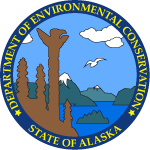| Action Date |
Action |
Description |
DEC Staff |
| 3/26/1993 |
Update or Other Action |
Department of Defense and ADEC joint Technical Memorandum of understanding signed concerning the Base-wide Groundwater. Signatories: ADEC SCRO-Jennifer Roberts Remedial Project Manager and USAF Joseph Williamson Chief Environmental Programs and Restoration.
As a result of the base-wide groundwater study and the FY92 field work that occurred at Operable Units (OUs) 1, 2, and 5 it appears that a large portion of the groundwater flows into OU5 (Attachment 1- Contour Map). Based on this information Elmendorf would like to move all upgradient groundwater into the OU5 Feasibility Study, Proposed Plan and Record of Decision. This means we would address all groundwater from upgradient sources (CERCLA (ST20, OU3, and OU4) and OUs 1 and portions of OU2) and SERA) at OU5 instead of at each individual source area (see Attachment 2 - Area Map). Those sites which have free phased product would be looked at to see if there is an available technology to clean them up in a cost effective way. Soil contamination would still be addressed at the source areas. NOTE: addressed at the source areas is interpreted by ADEC as removal through excavation or active treatment systems (e.g. high vacuum extraction, bioventing, etc.).
|
Jennifer Roberts |
| 11/17/1994 |
Site Added to Database |
Confirmed release of DRO. |
Former Staff |
| 11/17/1994 |
Site Ranked Using the AHRM |
Initial ranking. |
Louis Howard |
| 12/2/1994 |
Update or Other Action |
ADEC received notice of release and responded with confirmation letter. |
Louis Howard |
| 4/21/1995 |
Update or Other Action |
Air Force Memorandum to John Halverson re: UST meeting. Elmendorf AFB will accomplish the following actions regarding UST projects. These actions are based upon conversation between, John Mahaffey, Larry Opperman and yourself.
1) EAFB will make every effort to accomplish clean closure of a UST removal if possible. 2) UST removal locations requiring cleanup action will be transferred into the State Elmendorf Environmental Restoration Agreement (SERA). A list of sites requiring cleanup will be coordinated with your office. 3) The presumptive remedy for contaminated UST sites in the outwash plain only will be bioventing technology. 4) Contaminated soils exceeding cleanup levels may be placed back into the excavation only if the site assessment (SA) indicates a need for further action. 5) Contaminated UST sites not in the outwash plain will require further investigation to determine appropriate cleanup options. 6) We (Elmendorf) will make every attempt possible to assure new USTs or new aboveground tanks are not installed in any way that would hamper future access for cleanup. 7) The project will first accomplish removal of all the USTs. SA information will be used to prioritize sites for cleanup using existing project funds. Additional funding will be requested to complete cleanup if available. Sites not addressed for cleanup due to exhausted funding will be placed in SERA Phase IV.
John Halverson signed memorandum on April 21, 1995. Memorandum submitted by Douglas G. Tarbett, Maj. USAF, Chief Environmental Compliance (CCs 3 WG/JA and 3 SPTG/CE). |
John Halverson |
| 8/14/1995 |
Update or Other Action |
On February 21, 1995, staff sent the Air Force a letter with comments on site assessment reports prepared by EA Engineering for USTs it closed or upgraded during 1994. The reports were not complete and ADEC requested they be amended to provide the necessary information. Without the complete site assessment reports ADEC is unable to make determinations on site closure or the need for additional investigation or corrective action. Until information is submitted, the Air Force has not met its site assessment obligations and may be in violation of release investigation and corrective action requirements.
On March 28, 1995, ADEC sent the Air Force another letter providing comments on site assessment reports prepared by Haliburton NUS and Harding Lawson. Several of the sites may be appropriate for no further action decisions after additional information is provided. However, until it is submitted, ADEC cannot make such determinations.
The site assessment report for UST #336 which was supposed to be located at Building 42-335, stated the tank was not located and that soil borings were placed based upon historic drawings. However, on August 22, 1994, ADEC received a spill report from EAFB which states seepage of what was suspected to be heating oil was discovered during removal of an old UST at building 42-335. It appears likely that the tank removed was UST# 336 and a release was observed. ADEC requests additional documentation on the UST removal at building 42-335. |
John Halverson |
| 10/31/1995 |
Update or Other Action |
Site assessment for 500 gallon heating oil UST removal at Building 42-335 was conducted. The highest reported concentrations of petroleum hydrocarbons were found in Sample
101 SL collected from beneath the south end of Tank 335. Sample 1O1SL reportedly contained
.4,200 ppm TPH, 4,500 ppm DRO, and 16 ppm GRO. The sample also contained 0.151 ppm total
BTEX attributable to 0.01 ppm toluene, 0.021 ppm ethylbenzene, and 0.12 ppm xylenes.
Sample 10lSL did not contain detectable concentrations of benzene «0.005 ppm), HVOs «0.01 ppm and <0.005 ppm), PCBs «0.03 ppm), cadmium «0.5 ppm) and lead «5 ppm). Total arsenic and
chromium concenrrations were reported as 31 ppm and 16 ppm, respectively.
Samples 102SL and 103SL, collected from beneath the north end of Tank 335 and the southeast comer of the excavation below the product and return piping, respectively, contained 32 ppm to 64 ppm DRO, and 3.6 ppm to 4.2 ppm total lead. GRO was below the 1 ppm detection
level.
Sample 104SL, collected from Stockpile #1, contained 5,800 ppm TPH and 4,200 ppm DRO, for a calculated RPH concentration of 1,600 ppm. GRO, which was below the 1 ppm detection level, was assumed to be zero for the RPH calculation. The sample did not contain detectable concentrations of BTEX «0.005 ppm), HVOs «0.01 ppm and <0.005 ppm), PCBs «0.03 ppm), and leachable arsenic, cadmium, chromium and lead «0.5 ppm and <0.1 ppm).
Sample 105SL, collected from Stockpile #2, contained 78 ppm DRO and 8.8 ppm total lead. Again, GRO was below the 1 ppm detection limit.
Soils at the southern end of the former UST were found to contain 4,500 mg/kg DRO which is above level "B" criteria. The presence of impacted soils at the same end as the vent, fill and product and return piping connections, suggest release mechanisms may be from the piping connection problems. A split or break, was observed by the consultant in the product and return piping during the tank removal. Additionally, if the tank installation pre-dates the placement of asphalt pavement, overfills were also a possible release mechanism. Petroleum hydrocarbon indications were encountered within about six inches of the asphalt pavement on the south end of the excavation suggesting a product release at the ground surface near the fill/vent piping.
Based on the data presented herein and our interpretations of the conditions at the former
UST location, petroleum hydrocarbon concentrations in excess of ADEC Level B cleanup criteria
remain in the soil. Soils remaining beneath the southern end of former Tank 335 was found to
contain 4,500 ppm DRO. Soil beneath the northern end of the UST and beneath the product and
return lines contained concentrations below the Level B cleanup criteria. Based on the test results, a release investigation and/or corrective action is needed at the tank site, as stipulated in 18 AAC 78.
Roughly 12 cubic yards of excavated soil met Level B cleanup criteria, and nine cubic yards of soil in Stockpile #1 exceeded Level B criteria. On June 9, 1995, Stockpile #1 was combined with approximately 200 cubic yards of soil from a nearby UST removal location and hauled to ASR of Anchorage, Alaska for thermal treatment. The EAFB Fire Department was notified of the historic petroleum release on August 22, 1994. The EAFB Fire Department claimed responsibility for notifying ADEC of the release.
|
Louis Howard |
| 12/8/1995 |
Update or Other Action |
Section 2.2.5 Page 2-8: It states that soil and groundwater contamination were identified during closure of the UST and that soil matrix cleanup level B applies. If releases at the site have impacted groundwater, matrix cleanup level A applies, rather than level B. |
John Halverson |
| 10/17/1996 |
Institutional Control Record Established |
Air Force memo: Restricted Use of the Shallow Aquifer on Elmendorf Air Force Base (EAFB) signed by William R. Hanson P.E. GM-14 Chief Environmental Flight dated October 17, 1996 Memorandum for 3 SPTG/CEC/CEO from 3 SPTG/CEV:
1) Due to the contamination and commitments to regulators the use of the shallow aquifer for any purpose on Elmendorf is not allowed. Please see the attached Facility Board minutes (March 29, 1994 0930-Item 9 of minutes). Mr. William Hanson, Chief of Environmental, briefed to the Facilities Board the policy to not use the shallow water aquifer due to contamination. The Facilities Board approved this policy. Minutes approved by Thomas R. Case Brigadier General USAF Commander. The Installation Restoration Program (IRP) has additional Record of Decisions (RODs) for Operable Units 3 and 6 which require, as a stipulation of the agreement with Environmental Protection Agency and Alaska Department of Environmental Conservation, this aquifer remain unused.
2) Our concern is that key personnel in the review process within Civil Engineer Squadron are aware of these policies and that these policies are reviewed on a recurring basis. It is imperative that this restriction be recognized and observed during engineer reviews and operations.
3) If you have questions on this subject, please contact Mr. Joe Williamson at 552-7229. |
Jennifer Roberts |
| 3/31/1997 |
Update or Other Action |
AFID 335 SERA Phase IV ST405, Release Investigation report Draft Final March 1997 received.
Petroleum hydrocarbon contamination was detected by ATH and odor in 405WL01 from the approximate
base of former UST 335 (10 feet bgs) to groundwater and in the smear zone of 405PZ01 and
405PZ03. For this reason the analytical results were compared to ADEC level A cleanup standards.
DRO was detected in sample 405WL01 at 11.5 feet bgs (3,450 mg/kg) and 26 feet bgs (1,530 mg/kg).
Site disposition recommendations for AFIO 335 at ST405 will be submitted under separate cover pending the completion of risk assessment work on the affected areas. |
Louis Howard |
| 6/3/1998 |
Update or Other Action |
Letter from ADEC to Air Force (J. Mahaffey)- RE: Corrective Action for SERA Phase IV Sites. The Alaska Department of Environmental Conservation (Department) has reviewed the release investigations reports received in March of 1997 by the Air Force as part of the SERA IV Release Investigation Project. Based on information contained in the release investigation and previously submitted site assessment reports, the Department requests the Air Force to begin correction action on contaminated soils associated with decommissioned underground storage tanks (UST) at the following sites:
1. ST 401; AFIDs 96-104 associated with Building # 22-013,
2. ST 402; AFID 150, associated with Building # 32-127,
3. ST 403; AFIDs 209 & 229, associated with Building # 22-009,
4. ST 422; AFID 471, associated with Building # 41-701,
5. ST 424; AFID 189, associated with Building # 32-189,
6. ST 405; AFID 335, associated with Building 42-335,
7. ST 419; AFIDs 51 & 52, associated with Building # 41-659,
8. ST 407; AFIDs 575, 576 & 578, associated with Building # 43-575,
9. ST 410; AFID 165, associated with Building “Hush House”,
10. ST 421; AFID 425A, B, C & D, associated with Building # 42-425, and
11. ST 428; AFID130, associated with Building # 1-836.
SERA IV sites not listed above may need further release investigation work, or the contamination may be low enough to justify a “no further action” response.
Since all the SERA IV sites listed above have soil contamination that extends to ground water, and groundwater sampling was not performed as part of the SERA IV release investigations, the Department is assuming the groundwater is also contaminated. The Department is requesting the Air Force to submit a corrective action plan to address the contaminated groundwater, or submit a groundwater sampling plan to find the extent of groundwater contamination associated with the decommissioned UST. |
Tim Stevens |
| 10/9/2000 |
Update or Other Action |
Staff sent letter on 10/09/2000 certified mail number 388 516 845 and Air Force received it on 10/25/2000. 21 day deadline for response to corrective action request for SERA Phase IV Sites Letter dated June 9, 1998 is on November 8, 2000 at 5:00 PM. On June 9, 1998 the Alaska Department of Environmental Conservation (ADEC) sent EAFB a letter requesting a release investigation work plan for the groundwater contamination since soil contamination reaches groundwater for all of the sites listed below.
ADEC requests EAFB provide any information that a release investigation work plan has been submitted for the sites listed below or that an investigation has been conducted to characterize the full extent of groundwater contamination associated with these sites. If no work plan was ever submitted, then ADEC requests EAFB submit a release investigation work plan for its review and comment. ADEC also requested in the June 1998 letter that EAFB begin corrective action on contaminated soils at the following sites:
ST 401 AFIDs 96-104 associated with Building 22-013, ST 402 AFID 150 associated with Building 32-127, ST 403 AFIDs 209 and 229 associated with Building 22-009, ST 422 AFID 471 associated with Building 41-701, ST 424 AFID 189 associated with Building 32-189, ST 405 AFID 335 associated with Building 42-335, ST 419 AFIDs 51 and 52 associated with Building 41-659, ST 407 AFIDs 575, 576, 578 associated with Building 43-575, ST 410 AFID 165 associated with Building Hush House, ST 421 AFID 425A, B, C, D associated with Building 42-425, ST 428 AFID 130 associated with Building 1-836.
EAFB is awaiting finalization of the Spill Response Presumptive Remedy Memorandum of Understanding (MOU) prior to taking any action at the sites discussed above in anticipation of requesting that they be included in the MOU. ADEC does not concur with this delay and requests EAFB take prompt corrective action and characterization of the groundwater contamination at these sites. Past failure to adequately address this compliance issue prevents ADEC from considering these sites under the draft MOU and closing out the SERA Agreement. |
Louis Howard |
| 1/30/2002 |
Update or Other Action |
ST405 Removal Report received. Soil was removed to a depth of 14 feet deep, 23 feet long, 20 feet wide and 87 tons of soil was excavated and transported to ASR for treatment. Conclusions in the report were that a lack of contamination at 14 feet bgs but contamination detected at 26 feet bgs during the SERA investigation indicates a possible alternate source impacting the "smear zone" (The smear zone is defined as the range of depths within which the groundwater will fluctuate under normal seasonal conditions, and therefore, in which free product would move and “smear” the soil in response to these seasonal changes in the water level elevation.
The smear zone soils may therefore be saturated or unsaturated with groundwater at any given time.). The 1996 SERA investigation detected GRO at 920 mg/kg, DRO at 1,530 mg/kg, BTEX at 43.3 mg/kg, and benzene at 14 mg/kg in the smear zone. Groundwater is assumed to be at 28 feet bgs. |
Louis Howard |
| 10/21/2002 |
Update or Other Action |
Letter sent to Joe Williamson dissolving the State Elmendorf Environmental Restoration Agreement. The Alaska Department of Environmental Conservation (DEC) has reviewed the issue of abolishing the State Elmendorf Environmental Restoration Agreement (SERA) per your recommendation. Elmendorf Air Force Base and DEC entered into the SERA in 1992. The agreement was developed as a tool to bring the Base into compliance with Alaska's regulations addressing underground storage tanks, oil and other hazardous substance releases and solid waste.
Since that time, Elmendorf has made significant progress in investigating and cleaning up historic contamination problems. Many of the sites covered by the SERA have been successfully cleaned up and closed. Cleanup is underway at the remaining sites.
Additionally, Alaska has amended the regulations addressing fuel storage tanks, oil and other hazardous substance spills and solid waste. We concur with you that the SERA is no longer a necessary or beneficial. This letter serves as notice that DEC will end oversight on environmental work at Elmendorf by using the SERA. Instead, it is understood that the sites and programs formerly addressed by SERA: solid waste, underground storage tanks (UST), and oil and other hazardous substance discharges will be addressed in accordance with 18 AAC 60, 18 AAC 78 and 18 AAC 75. |
Jennifer Roberts |
| 12/5/2003 |
Long Term Monitoring Established |
Because ST405 is located in the OU 5 Groundwater study area and the Air Force is monitoring the groundwater on a regional basis, this site will be included as a part of that monitoring program. |
John Halverson |
| 12/5/2003 |
Conditional Closure Approved |
John Halverson Federal Facilities-Acting Section Manager sent a no further remedial action planned (NFRAP) letter to John Mahaffey re: Compliance funded sites review and response. Residual soil and/or groundwater contamination is present at all of the sites. Based on our review, thirty-six (36) of the sites do not appear to pose an unacceptable risk to human health or the environment and are suitable for a No Further Remedial Action Planned (NFRAP) determination.
DEC's NFRAP determination indicates that no additional cleanup is necessary, but that institutional controls and/or long-term monitoring are necessary. We have determined that the groundwater impacts at these sites are being adequately addressed within the base-wide groundwater monitoring program and the Operable Unit 5 groundwater treatment system. Because petroleum contaminated soil (e.g. contaminant levels higher than Method 2 cleanup levels in Tables B1/B2 found in 18 AAC 75.341) remains at these sites, the Base Master Plan needs to be updated to document the locations of residual contamination and the need to manage contaminated soil properly during any future construction or excavation work.
Sites in addition to ST405 referred to in the letter include: 404, 405, 411, 413, 414, 415, 430/9, 431, 501, 502, 503, 504, 505/9, 511, 512, 513, 514, 515, 517, 518, 519, 520, 521, 525, 528, 530, 533, 535, 536, 537, 700, 701, 902, 903, 904, and 906. Sites ST 420 and ST 524 are not located within the capture zone of the Operable Unit 5 treatment system (the outwash plain) and contain higher contaminant levels. Therefore, the ADEC is requesting additional site characterization at these two sites. |
John Halverson |
| 12/5/2003 |
Update or Other Action |
The following policy applies for soil regulated under 18 AAC 75 and 18 AAC 78 that is proposed for disposal off site from where it was generated. If the following criteria is met, ADEC approval and/or an institutional control(s) are not required: 1. The soil meets the most stringent Method Two, Migration to Groundwater, Table B2 cleanup level, and the most stringent standards for those chemicals under Table B1; 2. The soil may only be disposed of at any non-environmentally sensitive location in the Under 40" or Over 40" annual precipitation zone; 3. The soil is not placed within 100 feet of water wells, surface waters, and drainage ditches; and 4.The written approval from the landowner of the off-site location is required. The off site disposal of all other soil subject to the site cleanup rules that does not meet the criteria above shall be reviewed by the ADEC project manager in order to determine if the off-site disposal action poses a current or future risk to human health or the environment. The final approval to dispose of soil off site that does not meet the criteria shall be made by the ADEC Section Manager.
Terms used in this document have the meaning given in 18 AAC 75.990 including: “environmentally sensitive area” means a geographic area that, in the department's determination, is especially sensitive to change or alteration, including: (A) an area of unique, scarce, fragile, or vulnerable natural habitat; (B) an area of high natural productivity or essential habitat for living organisms; (C) an area of unique geologic or topographic significance that is susceptible to a discharge; (D) an area needed to protect, maintain, or replenish land or resources, including floodplains, aquifer recharge areas, beaches, and offshore sand deposits; (E) a state or federal critical habitat, refuge, park, wilderness area, or other designated park, refuge, or preserve; and (F) an area that merits special attention as defined at 6 AAC 80.170 (Repealed see AS 46.40.210(1))
“area which merits special attention” means a delineated geographic area within the coastal area which is sensitive to change or alteration and which, because of plans or commitments or because a claim on the resources within the area delineated would preclude subsequent use of the resources to a conflicting or incompatible use, warrants special management attention, or which, because of its value to the general public, should be identified for current or future planning, protection, or acquisition; these areas, subject to council definition of criteria for their identification, include: (A) areas of unique, scarce, fragile or vulnerable natural habitat, cultural value, historical significance, or scenic importance; (B) areas of high natural productivity or essential habitat for living resources; (C) areas of substantial recreational value or opportunity; (D) areas where development of facilities is dependent upon the utilization of, or access to, coastal water; (E) areas of unique geologic or topographic significance which are susceptible to industrial or commercial development; (F) areas of significant hazard due to storms, slides, floods, erosion, or settlement; and (G) areas needed to protect, maintain, or replenish coastal land or resources, including coastal flood plains, aquifer recharge areas, beaches, and offshore sand deposits.
|
Louis Howard |
| 4/20/2004 |
Update or Other Action |
Site moved from LUST to CS DB this date. Facility ID = 1525, Event ID = 417, File L77.95. |
Former Staff |
| 2/8/2007 |
GIS Position Updated |
TOPOZONE application NAD 83/WGS84 D/M/S coordinate, in combination with site map figure from January 2002 ST405 Removal Action Report dated January 2002 page 1-3 Figure 1-1 dated January 28, 2002 layout table ST424 Loc "ST405 Location Map". |
Louis Howard |




